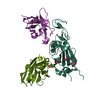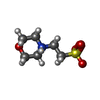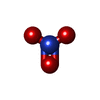+Search query
-Structure paper
| Title | Structural and functional characterization of nanobodies that neutralize Omicron variants of SARS-CoV-2. |
|---|---|
| Journal, issue, pages | Open Biol, Vol. 14, Issue 6, Page 230252, Year 2024 |
| Publish date | Jun 4, 2024 |
 Authors Authors | Katy Cornish / Jiandong Huo / Luke Jones / Parul Sharma / Joseph W Thrush / Sahar Abdelkarim / Anja Kipar / Siva Ramadurai / Miriam Weckener / Halina Mikolajek / Sai Liu / Imogen Buckle / Eleanor Bentley / Adam Kirby / Ximeng Han / Stephen M Laidlaw / Michelle Hill / Lauren Eyssen / Chelsea Norman / Audrey Le Bas / John Clarke / William James / James P Stewart / Miles Carroll / James H Naismith / Raymond J Owens /   |
| PubMed Abstract | The Omicron strains of SARS-CoV-2 pose a significant challenge to the development of effective antibody-based treatments as immune evasion has compromised most available immune therapeutics. ...The Omicron strains of SARS-CoV-2 pose a significant challenge to the development of effective antibody-based treatments as immune evasion has compromised most available immune therapeutics. Therefore, in the 'arms race' with the virus, there is a continuing need to identify new biologics for the prevention or treatment of SARS-CoV-2 infections. Here, we report the isolation of nanobodies that bind to the Omicron BA.1 spike protein by screening nanobody phage display libraries previously generated from llamas immunized with either the Wuhan or Beta spike proteins. The structure and binding properties of three of these nanobodies (A8, H6 and B5-5) have been characterized in detail providing insight into their binding epitopes on the Omicron spike protein. Trimeric versions of H6 and B5-5 neutralized the SARS-CoV-2 variant of concern BA.5 both and in the hamster model of COVID-19 following nasal administration. Thus, either alone or in combination could serve as starting points for the development of new anti-viral immunotherapeutics. |
 External links External links |  Open Biol / Open Biol /  PubMed:38835241 PubMed:38835241 |
| Methods | EM (single particle) / X-ray diffraction |
| Resolution | 1.73 - 4.0 Å |
| Structure data | EMDB-17295, PDB-8oyt: EMDB-17296, PDB-8oyu:  PDB-8owt:  PDB-8owv:  PDB-8oww: |
| Chemicals |  ChemComp-NAG:  ChemComp-MES:  ChemComp-HOH:  ChemComp-GOL:  ChemComp-EDO:  ChemComp-NO3: |
| Source |
|
 Keywords Keywords | VIRAL PROTEIN / Nanobody / Complex / Receptor binding domain / SARS-CoV-2 / spike |
 Movie
Movie Controller
Controller Structure viewers
Structure viewers About Yorodumi Papers
About Yorodumi Papers









